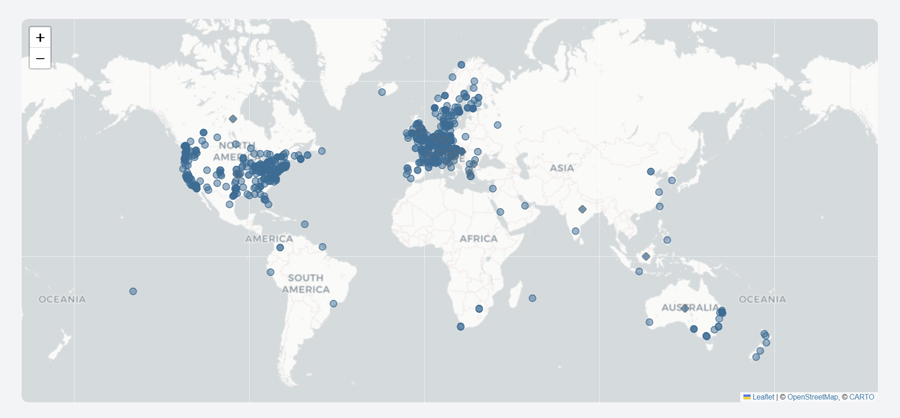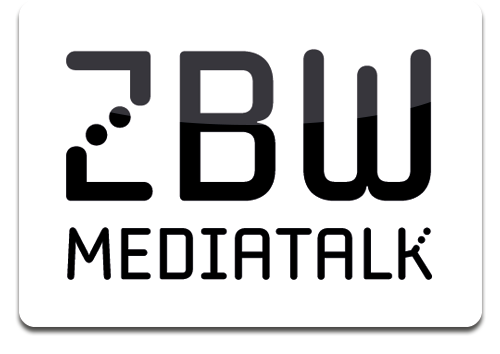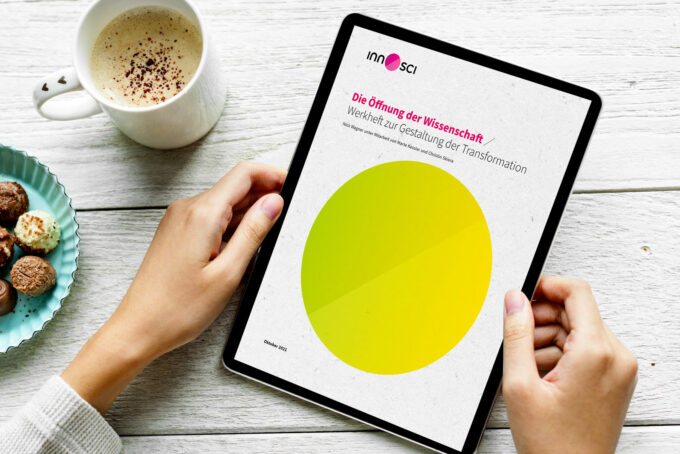
TSOSI: Making Funding for Open Science Infrastructure the Norm
While Open Science infrastructures are used a lot, their funding is precarious. TSOSI is a project that aims to improve this situation by making financial support for open infrastructure more visible. The project leader, Maxence Larrieu, gives some insights in TSOSIs goals, operations and functioning of its platform.
we were talking with Maxence Larrieu (University of Grenoble Alpes)

Transparency to Sustain Open Science Infrastructure (TSOSI) is a new web platform first released this summer. Maxence Larrieu, the project leader at University of Grenoble Alpes describes in this interview how TSOSI wants to make financial support for Open Infrastructures the norm.
What are your intentions and goals with the TSOSI project?
The very goal of TSOSI is to make funding for Open Science infrastructure the norm. In fact, we have observed that these infrastructures are used widely, whereas only a small part of its users financially support them (see Putting down roots: Securing the future of open access policies, p. 20, 2016). TSOSI aims to make financial support for open infrastructures as evident as buying a book or paying to access some online content. The project takes its roots in other initiatives like the “2.5% Commitment” (2017) , which calls research libraries to dedicate this percentage of their total budget to open infrastructures. TSOSI aims to contribute to the financial health of open infrastructures, such as those in the SCOSS family, arXiv, DOAJ, DOAB, SciPost, OpenCitations, SoftwareHeritage, Dataverse, AJOL, Episciences, and so on.
These infrastructures allow researchers to practice science by sharing their results; one challenge is to make them both free to use and sustainable. Open infrastructures rely on funding from a diversity of organisations and means to achieve their financial sustainability, as shown in Scoping the Open Science Infrastructure Landscape in Europe (PDF: 2020, graph number 56) report.

TSOSI’s goal is to broaden the financial support of open infrastructures. One of its guiding principle is that “the more we highlight those who have supported open infrastructures, the more supporters we will attract”.
What is transparency to Sustain Open Science infrastructures and how do you assess it?
To begin with, I compare TSOSI with OpenAPC, because both of them are Open Data solutions: OpenAPC shed light on the APC (Article Processing Charges) that has been paid by institutions to publish in Open Access, while TSOSI makes financial supports made for open infrastructures visible. Both of them disseminate Open Data and also include data visualisation in web application. Of course, they are technically comparable but their goals are not, because there is considerable difference between paying to publish in Open Access and paying to support open infrastructures (in fact, a TSOSI slogan could be “forget APC, support open infrastructures”).

This world map represents the locations of all the entities that have financially contributed to the infrastructure. Supporters with a specific location are represented by circles, while those for which TSOSI only has information at the country level are represented by diamond shapes. The location data comes from ROR and Wikidata. 1033 supporters out of 1035 are included in the world map.
About the assessment, the easiest way would be to observe the quantity of entities involved in the TSOSI network. As shown in the home page, as of October 2025, there are five infrastructures, with 1.035 organisations supporters from 47 different countries. And of course it’s just the beginning: TSOSI is keen on including new infrastructures, feel free to contact TSOSI.
How does the TSOSI platform work?
TSOSI gets the data from the infrastructures. DOAJ, DOAB/OAPEN, OPERAS, Peer Community In and SciPost have shared spreadsheets that describe their income. The basic data of these spreadsheets are: name of the supporting organisation, date of the financial support, amount of the transfer, and, if any, the name of the consortium. Then, the operational team of TSOSI adds identifiers to institutions. TSOSI relies on two global persistent identifiers, the ROR and the Wikidata one. Finally, the enriched data are ingested in a database and the web application with data visualisations allows everyone to explore the funding network.
Who is behind the project and how is it organised?
The project started in 2024 thanks to funding from the French Committee for Open Science and with support from the Université Grenoble Alpes. The web platform was first released in June 2025 with an inaugural webinar in the same month (see the summary on TSOSI’s blog). For its launch, the operational team behind the project is composed by a project manager and a web and data engineer. TSOSI also relies on the research unit GRICAD for IT services and the administrative support.
Since its beginning in September 2024, the operational team has been working with a total of 11 people involved in three committees that compose the governance of TSOSI. I would like to thank all of them for their involvement. The advisory board is composed of representatives from SCOSS, DOAB, DOAJ and OPERAS. The user group involved Peer Community In, SciPost and Couperin. Finally, the supervision group is composed of two representatives from the French Committee for Open Science and Université Grenoble Alpes.
What challenges do you see in funding Open Science infrastructures?
TSOSI aims to make support for open infrastructures the norm. Essentially, it’s not because it’s free to use, that it is run at no cost. The Diamond Open Access publishing platform SciPost has made an important effort to provide statistics on the institutions that support it and the ones that benefit from the platform – that is, the institutions of authors whose articles are published. They unfortunately observed that “Of more than 1200 benefitting organisations, only 135 have contributed to our sustenance” (Diamond sustainability requires sustenance, 2024). One challenge here is to sensitise the institutions about the opportunity they have to support open infrastructures. In some way, if one institution is much more aligned with the value of Open Library for Humanities than that Wiley, the institution should be much more proud of supporting the former than contracting with the latter – this is what Demmy Verbeke named accurately “values-aligned investments” (How Open Investing Will Transform Library Collections, 2024).
It’s another goal on the horizon of TSOSI, that institutions be proud of supporting open infrastructures. During my experience at research libraries I have seen that we are used to communicate a new contract with a traditional publisher, like a read and publish one, but when it’s about a support for an open infrastructure, no such communications is done – open infrastructures usually remain hidden, as pointed out in the introduction of the blogpost of the Principles for Open Scholarly Infrastructures (2015). TSOSI aims to bring support for open infrastructures to the forefront so that every research stakeholder is accustomed to engaging with, supporting, and communicating their interactions with open infrastructures.
The idea here is to consider the ecosystem of which the institutions are part. For decades, they have been used to buy various books and journals. With time, this acquisition process has led to a strong administrative organisation involving publishers, institutions, consortia, negotiations, contracts, invoices, and payments. Open infrastructures are relatively recent compared to centuries-old publishing traditions (arXiv was launched in 1991), and this administrative scheme is not applicable to them: it’s no more about acquiring content. The point here is that the global research community has to rethink and update the funding mechanism that has been in place for decades, so that it can shape the open infrastructure landscape of tomorrow. In the last few years, we have observed news initiatives that are part of this process, such as the Diamond Open Access fund from the University of Amsterdam, the KOALA Consortium, the Open Book Collective, and the new European Diamond Capacity Hub. TSOSI, with other initiative like SCOSS or Invest in Open, is dedicated to facilitating this shift toward funding for open infrastructures.
TSOSI provides a good overview of the Open Science landscape. What developments can you identify?
TSOSI started with data from five infrastructures: DOAJ, DOAB, OPERAS, PCI and SciPost to build a proof of concept. Even if it’s a small part of the Open Science funding landscape, we already have good feedback from the community, especially libraries, research institutions, consortia, and research funding organisations. Considering the developments, TSOSI will enhance its Open infrastructures funding network by integrating new infrastructures. Since we work closely with SCOSS, the same criteria will be used to welcome infrastructures, and the ones that are already part of the SCOSS family are very welcome!
Another important development will be to design a process to collect data from the institutions. Indeed, for the moment, TSOSI’s data comes from the infrastructures. It is a considerable limit, because institutions, for the moment, can only see a portion of their support. Collecting data from infrastructures and institutions, however, implies a technological and community challenge to avoid duplicate data. TSOSI will have to design a process to identify duplicated data and allow providers to curate it. On this topic, we are keen to work with openCost, which has started to make a data model to describe contracts made also with open infrastructures.
These two developments will strengthen the TSOSI open infrastructures funding network by integrating new institutions and infrastructure. In this way, TSOSI has the potential to become a valuable tool for supporting the financial sustainability of open infrastructures.
This might also interest you:
- Open Access Days 2025: Goal Achieved – or how can it (Ever) be Accomplished?
- Open Access Barcamp 2025: From Best Practices and Visions to Triage in Publication Funds
- Barcamp Open Science 2025: From Threats to Collective Resilience
- Ambitious Pioneer for Open Science: These are the top Priorities at the EOSC Association
- Financing Diamond Open Access for Economics Sciences: How OLEcon Works
We were talking with:
Maxence Larrieu is the project leader of Transparency to Sustain Open Science Infrastructure (TSOSI). He has been working at the University of Grenoble Alpes since 2023 as a data steward. He obtained his PhD in 2018 at Paris-Est University in digital humanities. Since 2015, he has been working to implement Open Science at the institutional level in different research universities. He has been engaged in research data, Diamond Open Access, monitoring Open Science, and Open Access repositories. Besides TSOSI, one of his latest famous projects is the Diamond Open Access publishing platform OPUS, opus.u-paris.fr running entirely on software from the Public Knowledge Project. He is currently the pilot of one of the national Open Science working groups led by the French Committee for Open Science.
Portrait: flickr©
View Comments

24/7 Opening of University Libraries: New Flexibility for Concentrated Work Leads to Record Start
A sharp rise in demand for library cards, a library that is often busier at weekends...



